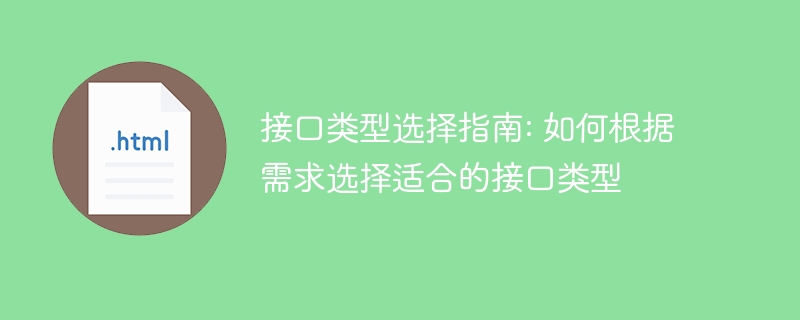接口类型选择指南: 如何根据需求选择适合的接口类型

接口类型选择指南: 如何根据需求选择适合的接口类型,需要具体代码示例
导言:
在开发软件中,接口是不可或缺的组成部分。选择适合的接口类型对于软件的功能和性能是至关重要的。本文将介绍几种常见的接口类型,并提供代码示例,帮助读者根据实际需求进行选择。
一、同步接口:
同步接口是最常见的接口类型之一,它在发送请求后等待接收到响应后才能继续执行。同步接口通常用于需要实时反馈结果的场景,例如查询数据、提交表单等。以下是一个使用同步接口的示例:
import requests
def get_user_info(user_id):
url = f"https://api.example.com/user/{user_id}"
response = requests.get(url)
if response.status_code == 200:
return response.json()
else:
return None
user_info = get_user_info(123)
if user_info:
print("用户信息:", user_info)
else:
print("未找到用户信息")二、异步接口:
与同步接口不同,异步接口发送请求后不等待响应,而是继续执行其他任务。一段时间后,通过回调函数或轮询等方式获取结果。异步接口通常用于耗时较长的操作,例如下载文件、发送邮件等。以下是一个使用异步接口的示例:
import asyncio
import aiohttp
async def download_file(url, save_path):
async with aiohttp.ClientSession() as session:
async with session.get(url) as response:
if response.status == 200:
with open(save_path, 'wb') as file:
while True:
chunk = await response.content.read(1024)
if not chunk:
break
file.write(chunk)
asyncio.run(download_file("https://example.com/file.jpg", "file.jpg"))
print("下载完成")三、RESTful API:
RESTful API 是一种基于 HTTP 协议的接口设计风格,广泛应用于网络开发中。它使用统一的资源地址,通过 HTTP 方法(GET、POST、PUT、DELETE 等)来操作资源。以下是一个使用 RESTful API 的示例:
import requests
def create_user(user_info):
url = "https://api.example.com/user"
response = requests.post(url, json=user_info)
if response.status_code == 201:
return response.json()
else:
return None
new_user_info = {"name": "John", "age": 25, "email": "john@example.com"}
new_user = create_user(new_user_info)
if new_user:
print("创建用户成功,用户信息:", new_user)
else:
print("创建用户失败")四、GraphQL API:
GraphQL 是一种灵活、高效的查询语言和运行时,用于构建 API。相比于传统的 RESTful API,GraphQL 允许客户端通过查询语句精确地定义需要返回的数据。以下是一个使用 GraphQL API 的示例:
import requests
def get_user_info(user_id):
url = "https://api.example.com/graphql"
query = """
query getUser($id: ID!) {
user(id: $id) {
name
age
email
}
}
"""
variables = {"id": user_id}
headers = {"Content-Type": "application/json"}
response = requests.post(url, json={"query": query, "variables": variables}, headers=headers)
if response.status_code == 200:
return response.json()["data"]["user"]
else:
return None
user_info = get_user_info("123")
if user_info:
print("用户信息:", user_info)
else:
print("未找到用户信息")五、消息队列:
消息队列是一种在应用程序之间进行异步消息传递的技术。它通常用于解耦发送者和接收者之间的联系,提高系统的可伸缩性和可靠性。以下是一个使用消息队列的示例:
import pika
def receive_message(ch, method, properties, body):
print("收到消息:", body.decode())
connection = pika.BlockingConnection(pika.ConnectionParameters('localhost'))
channel = connection.channel()
channel.queue_declare("hello")
channel.basic_consume(queue="hello", on_message_callback=receive_message, auto_ack=True)
channel.start_consuming()结语:
本文介绍了几种常见的接口类型,包括同步接口、异步接口、RESTful API、GraphQL API 和消息队列。希望通过具体的代码示例,读者能够根据实际需求选择合适的接口类型。当然,不同的接口类型还有更复杂的使用场景和更丰富的功能,读者可以进一步深入学习和探索。
以上是接口类型选择指南: 如何根据需求选择适合的接口类型的详细内容。更多信息请关注PHP中文网其他相关文章!

热AI工具

Undresser.AI Undress
人工智能驱动的应用程序,用于创建逼真的裸体照片

AI Clothes Remover
用于从照片中去除衣服的在线人工智能工具。

Undress AI Tool
免费脱衣服图片

Clothoff.io
AI脱衣机

AI Hentai Generator
免费生成ai无尽的。

热门文章

热工具

记事本++7.3.1
好用且免费的代码编辑器

SublimeText3汉化版
中文版,非常好用

禅工作室 13.0.1
功能强大的PHP集成开发环境

Dreamweaver CS6
视觉化网页开发工具

SublimeText3 Mac版
神级代码编辑软件(SublimeText3)

热门话题
 硬盘的接口类型有哪些
Mar 13, 2024 am 10:40 AM
硬盘的接口类型有哪些
Mar 13, 2024 am 10:40 AM
硬盘的接口类型:1、SATA接口,串口硬盘;2、IDE接口,电子集成驱动器;3、SCSI接口,小型计算机系统接口;4、SAS接口,电脑集线技术;5、M.2接口,主机接口方案;6、光纤通道硬盘接口,专门为网络设计的接口。
 接口类型有哪些
Dec 22, 2023 am 11:35 AM
接口类型有哪些
Dec 22, 2023 am 11:35 AM
常见接口类型有VGA接口、HDMI接口、DP接口、DVI接口、USB接口、RJ45接口、HDMI/MHL接口、Micro USB接口、Type-C接口、3.5mm耳机接口等。详细介绍:1、VGA接口:用于连接显示器,是一种模拟信号接口;2、HDMI接口:用于连接高清多媒体设备,是一种数字信号接口;3、DP接口:DisplayPort的简称,是一种数字式视频接口标准等等。
 硬盘接口类型有哪些
Oct 19, 2023 pm 05:31 PM
硬盘接口类型有哪些
Oct 19, 2023 pm 05:31 PM
硬盘接口类型有IDE、SATA、SCSI、Fibre Channel、USB、eSATA、mSATA、PCIe等等。详细介绍:1、IDE接口是一种并行接口,主要用于连接硬盘和光驱等设备,它主要有两种类型:ATA和ATAPI,IDE接口已经逐渐被SATA接口;2、SATA接口是一种串行接口,相较于IDE接口,它具有更高的传输速度、更低的功耗和更小的体积;3、SCSI接口等等。
 如何进行Java开发项目的需求分析与设计
Nov 02, 2023 pm 04:03 PM
如何进行Java开发项目的需求分析与设计
Nov 02, 2023 pm 04:03 PM
如何进行Java开发项目的需求分析与设计随着互联网的迅猛发展,Java作为一种强大的编程语言,在软件开发领域越来越受欢迎。而一个成功的Java开发项目不仅需要高效的编写代码,还需要进行良好的需求分析与设计。本文将详细介绍如何进行Java开发项目的需求分析与设计,帮助开发者打造优秀的软件。需求分析需求分析是Java开发项目的第一步,它是明确开发的目标和范围,明
 接口类型选择指南: 如何根据需求选择适合的接口类型
Dec 23, 2023 am 09:48 AM
接口类型选择指南: 如何根据需求选择适合的接口类型
Dec 23, 2023 am 09:48 AM
接口类型选择指南:如何根据需求选择适合的接口类型,需要具体代码示例导言:在开发软件中,接口是不可或缺的组成部分。选择适合的接口类型对于软件的功能和性能是至关重要的。本文将介绍几种常见的接口类型,并提供代码示例,帮助读者根据实际需求进行选择。一、同步接口:同步接口是最常见的接口类型之一,它在发送请求后等待接收到响应后才能继续执行。同步接口通常用于需要实时反馈
 对比前后端接口: 研究常见的前后端交互接口类型
Dec 23, 2023 pm 01:07 PM
对比前后端接口: 研究常见的前后端交互接口类型
Dec 23, 2023 pm 01:07 PM
前后端接口对比:探究前后端交互中常见的接口类型,需要具体代码示例一、引言随着互联网的快速发展,前后端分离的开发模式逐渐成为主流。在此模式中,前端开发人员和后端开发人员通过接口实现数据的交互和通信。因此,了解不同的接口类型以及其特点对于实现高效的前后端交互至关重要。本文将探究前后端交互中常见的接口类型,并提供具体的代码示例。二、常见的前后端接口类型RESTf
 如何在Go中使用接口类型?
May 11, 2023 pm 04:24 PM
如何在Go中使用接口类型?
May 11, 2023 pm 04:24 PM
Go语言是一种静态类型的编程语言,它支持接口类型的概念。接口类型是一种约定,它定义一个组件应该具有的方法集。这种约定可以使代码更加灵活、可重用,并且可以帮助我们实现更好的代码组织。本文将介绍如何在Go中使用接口类型,包括定义、实现和使用接口类型的技巧。一、定义接口类型在Go中定义一个接口类型非常简单,只需要声明一组方法即可。例如:typeWriterin
 php接口类型有哪些
Jul 21, 2023 am 10:41 AM
php接口类型有哪些
Jul 21, 2023 am 10:41 AM
php接口类型:1、普通接口,最基本的接口类型;2、可扩展接口,允许一个接口继承另一个接口;3、可继承接口,允许接口实现另一个接口并继承它的所有方法;4、变量接口,用于接收一个或多个对象,并对其进行操作;5、迭代器接口,用于遍历对象中的元素的常见接口类型;6、比较接口,用于比较两个对象的接口类型。






